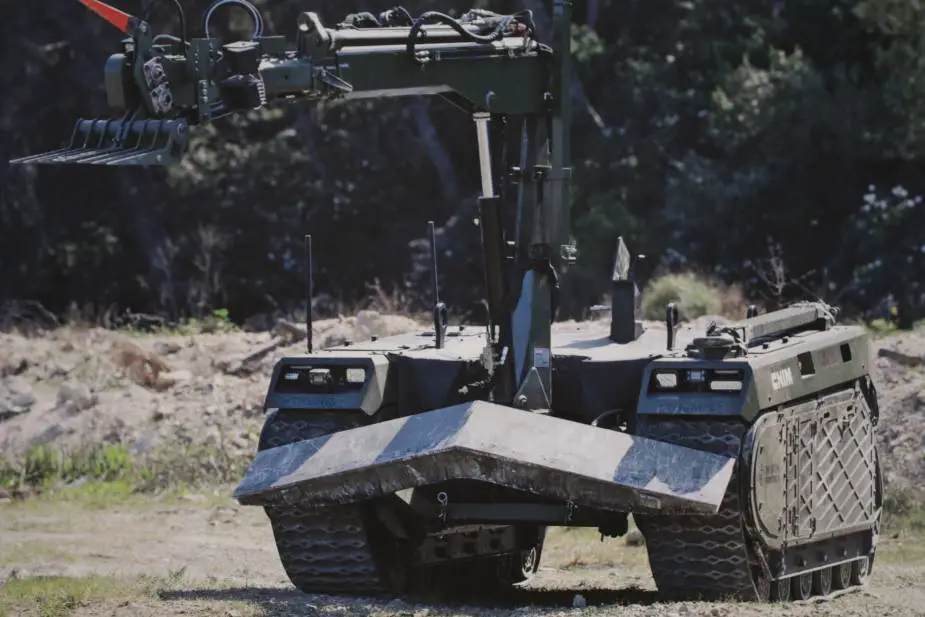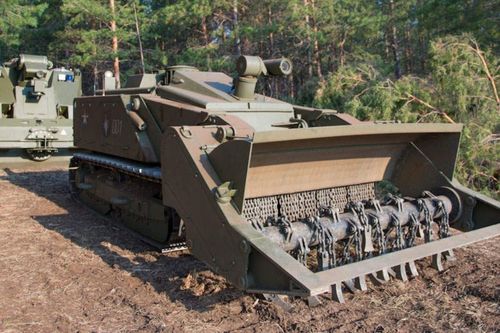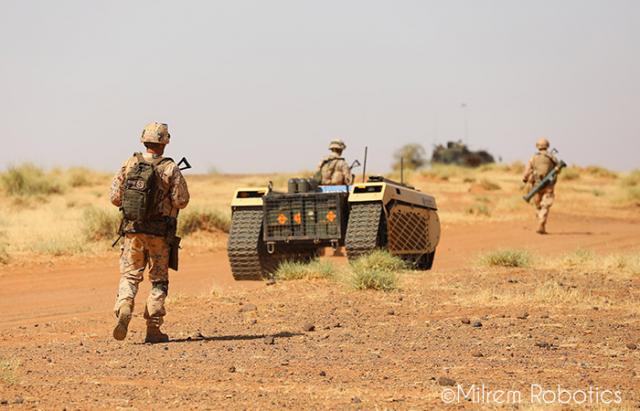FEINDEF 2023:
CNIM unveils ROCUS future Advanced Mine-Clearance Robot for Ukrainian army.
17 May, 2023 18:20 | 2023Road clearance vehicles, such as the ROCUS based on the THeMIS UGV, have increasingly important roles on modern battlefields due to their versatility and capability to protect military personnel from high-risk tasks.
At the forefront of their capabilities is their primary function – ensuring safe passage for military convoys. In conflict zones, the danger of mines, IEDs (Improvised Explosive Devices), and other forms of unexploded ordnance is ever-present. These threats can halt the advance of troops, disrupt supply chains, and cause significant harm to military personnel. Road clearance vehicles, equipped with advanced detection and neutralization technologies, can methodically scan and clear these routes, reducing the risk to human life and maintaining the flow of operations.
At the heart of the ROCUS system is its versatile manipulator arm. This critical component provides the robot with the flexibility and reach needed to handle, defuse, or safely detonate explosive devices. Equipped with multiple degrees of freedom, it can deftly maneuver around obstacles and into confined spaces, enabling it to perform delicate operations with precision.
Mounted on the manipulator's arm is an array of specialized tools. One of these is the end effector, or gripper, which can be a simple pincer for grabbing and lifting objects or a more specialized tool for tasks such as cutting wires or unscrewing components.
The THeMIS (Tracked Hybrid Modular Infantry System) is an innovative Unmanned Ground Vehicle (UGV) developed by Milrem Robotics.
- This Estonia-based defense solutions provider has designed THeMIS to be a multi-role combat vehicle, capable of performing a diverse array of tasks on the battlefield. With its advanced mobility system, it utilizes a tracked design to traverse a wide variety of terrains, enhancing its operational versatility.
- It has a range of up to 100 km and can operate up to 10 hours with a full tank of diesel fuel.
- The UGV can be remote-controlled or set to follow predefined routes autonomously
At Eurosatory 2024, CNIM Systèmes Industriels displays the Route Clearance Unmanned System (ROCUS), an advanced unmanned ground vehicle designed to enhance the safety and efficiency of military route clearance operations. CNIM Systèmes Industriels, a longstanding partner in the defense and security sector since 1856, continues to support armed forces with robust and reliable operational equipment. ROCUS is the latest addition to their suite of solutions aimed at protecting soldiers and ensuring mission success.
 |
| A key feature of ROCUS is its unmanned and remotely operated design, which significantly reduces the risk to soldiers by allowing operations to be conducted from the safety of a protected vehicle (Picture source: CNIM Systèmes Industriels) |
The ROCUS is engineered to operate in challenging terrains, providing a high degree of mobility with its tracked vehicle design, which ensures low ground pressure. It boasts an impressive performance capability, with a top speed of 20 km/h and an endurance of up to 10 hours. Equipped with a 4-meter robotic arm that can lift up to 100 kg, the ROCUS can perform a variety of tasks both day and night, thanks to its versatile operating capabilities.
A key feature of ROCUS is its unmanned and remotely operated design, which significantly reduces the risk to soldiers by allowing operations to be conducted from the safety of a protected vehicle. The unified command system streamlines control and coordination, enhancing the effectiveness of route clearance missions.
- The hybrid design of the vehicle reduces the logistic footprint, making it easier to transport and deploy in various operational scenarios.
- Additionally, the ROCUS is towable, adding to its ease of transport and flexibility in the field.
Improvised Explosive Devices (IEDs) have long posed a significant threat, causing numerous casualties and damaging military assets. ROCUS addresses this challenge by inspecting, confirming, and acting on potential threats, thus ensuring the safe passage of convoys and the successful completion of missions. Its robust and enduring design allows it to operate effectively in difficult terrains, combining endurance and carrying capacity to meet the demanding needs of military operations.
Eyes On Mediterranean And Black Sea: U.S. Navy MQ-4Cs Expand Operations In The 6th Fleet Area Of Responsibility

The Tritons recently delivered to Naval Air Station Sigonella have been busy lately, flying missions off Libya and the Eastern Mediterranean Sea, with some rare trips to the Black Sea.
Naval Air Station Sigonella, Italy, received on Mar. 30, 2024, its first MQ-4C Triton Unmanned Aerial System, followed by a second one on Apr. 19. Since then, the two aircraft, assigned to Unmanned Patrol Squadron (VUP) 19 “Big Red,” have been flying regular missions over the Eastern Mediterranean Sea and off the coasts of Libya.
It wasn’t until recently that a Triton was noticed in flight also over the Black Sea during a mission on Jun. 14. While many considered it as the first trip of the new UAV to the area, upon further investigation we found out that this was the second mission to the Black Sea, after the first one on Apr. 29.
The aircraft involved in both flights appears to be the first MQ-4C delivered to Sigonella, serial 169659. The Apr. 29 mission was assigned the callsign TRITON19, while the Jun. 14 mission used BLKCAT6. The latter is the callsign routinely used also during the missions on the Mediterranean Sea.
Until now, the Black Sea was surveilled by the U.S. Air Force RQ-4Bs Global Hawk and NATO RQ-4Ds Phoenix, while the MQ-4C Triton focused on the Mediterranean Sea. The move makes sense as the MQ-4C is intended to augment the ability of the P-8 Poseidon to provide broad area, intelligence, surveillance, reconnaissance and targeting capabilities, and the Poseidon regularly patrols the Black Sea.
As often explained here at The Aviationist, U.S. Navy P-8As and RQ-4s operating out of Sigonella can be regularly tracked online by means of their ADS-B/Mode-S transponders, providing interesting insights into their missions over the Mediterranean and Black Sea. In fact, since the invasion of Crimea in 2014, the United States and NATO maintained a daily Intelligence, Surveillance and Reconnaissance presence over the Black Sea.

The MQ-4C Triton
The MQ-4C Triton is the Navy’s newest Intelligence, Surveillance, and Reconnaissance Maritime Patrol asset and augments the capabilities of the P-8 Poseidon maritime patrol aircraft. The aircraft is based upon the U.S. Air Force’s RQ-4B Global Hawk, while its sensors are based upon components of (or entire systems) already fielded in the DoD inventory, according to NAVAIR’s description.
Also known as Broad Area Maritime Surveillance (BAMS), the MQ-4C platform will complement the P-8A Poseidon within the Navy’s Maritime Patrol and Reconnaissance Force family of systems. Aircrew gather and process surveillance information utilizing data fusion tools that integrate sensor data from multiple aircraft into a comprehensive networked picture to further assist in building an accurate threat representation.
After assembling lessons learned from Triton’s initial deployment to Guam in 2020, the MQ-4C received significant updates including an upgraded sensor suite. These enhancements increase Triton’s ability to provide a persistent maritime intelligence, surveillance, reconnaissance and targeting (MISR-T) capability.
The MQ-4C is believed to be a sort of Block 20 and Block 30 Global Hawk hybrid, carrying Navy payload including an AN/ZPY-3 multi-function active-sensor (MFAS) radar system, that gives the Triton the ability to cover more than 2.7 million square miles in a single mission that can last as long as 24 hours at a time, at altitudes higher than 10 miles, with an operational range of 8,200 nautical miles.
Interestingly, while the Navy initially planned to procure 68 aircraft and 2 prototypes, it appears the Joint Requirements Oversight Council (JROC) re-assessed the MQ-4C Triton inventory requirement and scaled it down to 27 airframes, attributed to the program as 22 production, and 5 development (includes 1 test asset, 1 stricken UA and 25 fleet assets).
VUP-19 achieved initial operation capability in September 2023 (two years later than initially planned) during its new deployment to Andersen Air Force Base. As the only Navy unmanned patrol squadron, the unit will set a baseline for training Sailors and officers on the tactics, techniques and procedures of operating the MQ-4C Triton for future warfighting. The number of UAS assigned to each detachment has not been disclosed.

.jfif)








No comments:
Post a Comment